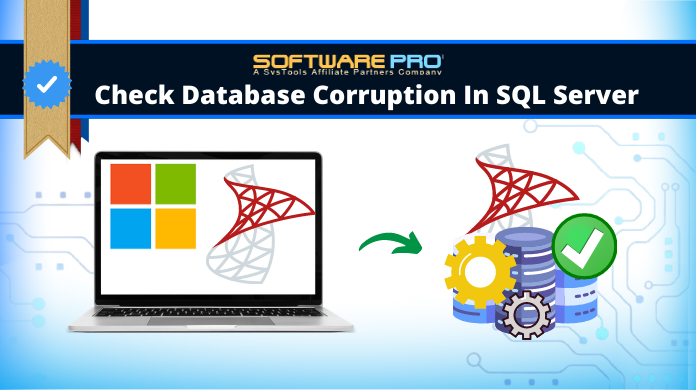How to Check Database Corruption in SQL Server – Simply Explained

SQL Server Administrators all over the world have had to deal with database corruption one time or the other in their careers as administrators. When dealing with database corruption in SQL server, the more early an administrator learns about it, the easier it becomes to resolve it. In what follows, you will learn the best methods to check database corruption in SQL Server.
But before we dig into the best ways to identify database corruption in SQL server, we will have a quick peek into what causes it. So, let’s jump right in.
CONTENT:
1. Cause of Database Corruption
2. Methods to Identify Database Corruption in SQL Server
3. Ways to Recover Corrupted SQL Server Database
4. Key Takeaways
5. F.A.Qs
Cause of Database Corruption
Although database corruptions are rare, when they do happen- one of these issues is usually the culprit behind:
- Abrupt power loss- The SQL server database can become corrupted if the system housing it experiences a sudden power outage or shutdown.
- Malware or Virus Attack- Database of SQL Server is susceptible to virus or malware attacks that can leave it corrupted or inaccessible for use.
- Transfer or Migration Error- This can happen when the files are not completely transferred during a transfer. It is a transfer of database files from a server to another version or from one database to another.
PRO Tip: You can use the SQL recovery software to resolve database corruption issues in SQL Server.
Methods to Check Database Corruption in SQL Server
Follow these simple methods to identify database corruption in SQL servers-
1. Database Alerts
2. DBCC CHECKDB
3. Backup With Checksum
1. Database Alerts
The administrator can set up alerts in SQL Server that will inform the user about the occurrence of an error.
To learn more about it, refer to this blog by Microsoft:
2. DBCC CHECKDB
The DBCC CHECKDB command is used to check the physical and logical integrity of your database. Moreover, DBBC CHECKDB will automatically run the DBCC CHECKALLOC, DBCC CHECKTABLE, or DBCC CHECKCATALOG commands.
Here is how Microsoft puts it on their blog :
Checks the logical and physical integrity of all the objects in the specified database by performing the following operations:
- Runs DBCC CHECKALLOC on the database.
- Runs DBCC CHECKTABLE on every table and view in the database.
- Runs DBCC CHECKCATALOG on the database.
- Validates the contents of every indexed view in the database.
Also Read: Upgrade SQL Server 2014 to 2019 Step by Step
3. Use Backup command with Checksum
Run backup command in the SQL server always along with checksum command. Doing so will ensure that if an error were to occur during the backup process, the User is notified of it.
This is how the command looks like:
BACKUP DATABASE XYZ
TO DISK=’E:\SQLBackup\XYZ.bak’
WITH CHECKSUM;
You can use the above methods to check for database corruption in SQL Server and make sure that your backups are safe and well-kept.
How to Handle Corruption Issues
In case you do end up with corruption issues, you can use the SoftwarePro tool which is enterprise software that will help you repair the corrupt SQL database.
It can, moreover, help you to recover corrupted or deleted database objects like views, stored procedures, functions, etc. Apart from this, it also has other features like recovery of ransomware-affected files, recovery of multiple NDF files, etc.
Read More: How to Recover Deleted Objects in SQL Server?
Key Takeaways
System database corruption in SQL server is an issue that many administrators face every day. And what’s even more problematic is that a lot of times, the administrators themselves are not aware of the corruption that has occurred in their databases.
This can and does, lead to problems in the future when a large number of database files have become corrupted. And this is the reason that as a database administrator, it is in your best interest to check database corruption in SQL server from time to time.
You can use the above-mentioned methods to perform the checks. And in case you do end up with corruption in your database, you can use a professional tool to repair it.
There are several scenarios where the user needs to migrate the SQL database to another server. However, if users have corrupted database objects, then this migration task seems quite difficult. In that case, there is no need to separately repair the corruption. The SQL Database Migration Tool can handle the entire task with ease.
FAQs
1. What is the best way to resolve database corruption in SQL server?
Answer. You can use a repair tool that will automate the recovery process for you without any hassles.
2. Before I check database corruption in SQL server, how do I know my SQL database is corrupted?Answer. You can find out if your database is corrupted or not by using 3 simple different way:
- Using the DBCC CHECKDB command
- Database Alerts
- Backup command with checksum
3. Can I use the CHECKDB command to resolve database corruption in SQL Server?
Answer. No. The command can only tell you if there is corruption in your server or not. Though, it cannot resolve it.


